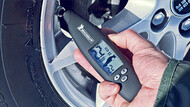
Learn
All you need to know about checking tire pressure

How to check tire pressure
Tires have been known to lose up to 1psi (pounds per square inch) every month, so check all tires, including your spare, once a month (or before a long trip).
It’s easy. Here’s how:
1. Purchase a trusted tire pressure gauge.
2. Check your tires “cold”—before you’ve driven or at least three hours after you’ve driven.
3. Insert tire pressure gauge into the valve stem on your tire. (If you are using a digital tire gauge like the one pictured, the gauge should begin reading the air pressure immediately. Refer to your air pressure gauge owner's manual for correct usage instructions. If using a pencil-style tire gauge, the gauge will pop out and show a measured number. When you hear a hissing sound, that’s air escaping the tire. The escaping air shouldn’t affect pressure substantially, unless you hold down the air pressure gauge too long.)
4. Compare the measured psi to the psi found on the sticker inside the driver’s door of your vehicle or in the owner’s manual. DO NOT compare to the psi on your tire’s sidewall.
5. If your psi is above the number, let air out until it matches. If below, add air (or have a Michelin retailer help you) until it reaches the proper number.
Low pressure can lead to tire damage. See the inflation difference:
Nitrogen versus compressed air
Most tires are filled with compressed air. But some tire retailers have started to put nitrogen into their customers’ tires. (Nitrogen is simply dry air with the oxygen removed. Air contains nearly 79% nitrogen already.) Because nitrogen replaces oxygen, less air can escape your tires, and your inflation pressure stays higher longer. Unfortunately, there are other possible sources of leaks (tire/rim interface, valve, valve/rim interface and the wheel), which prevent the guarantee of pressure maintenance for individuals using air or nitrogen inflation.
Nitrogen and compressed air CAN be mixed, if needed. Tires manufactured by Michelin are designed to deliver their expected performance when inflated with air or nitrogen, as long as the user respects the pressures recommended by the vehicle manufacturer on the vehicle’s placard or by the tire manufacturer.







